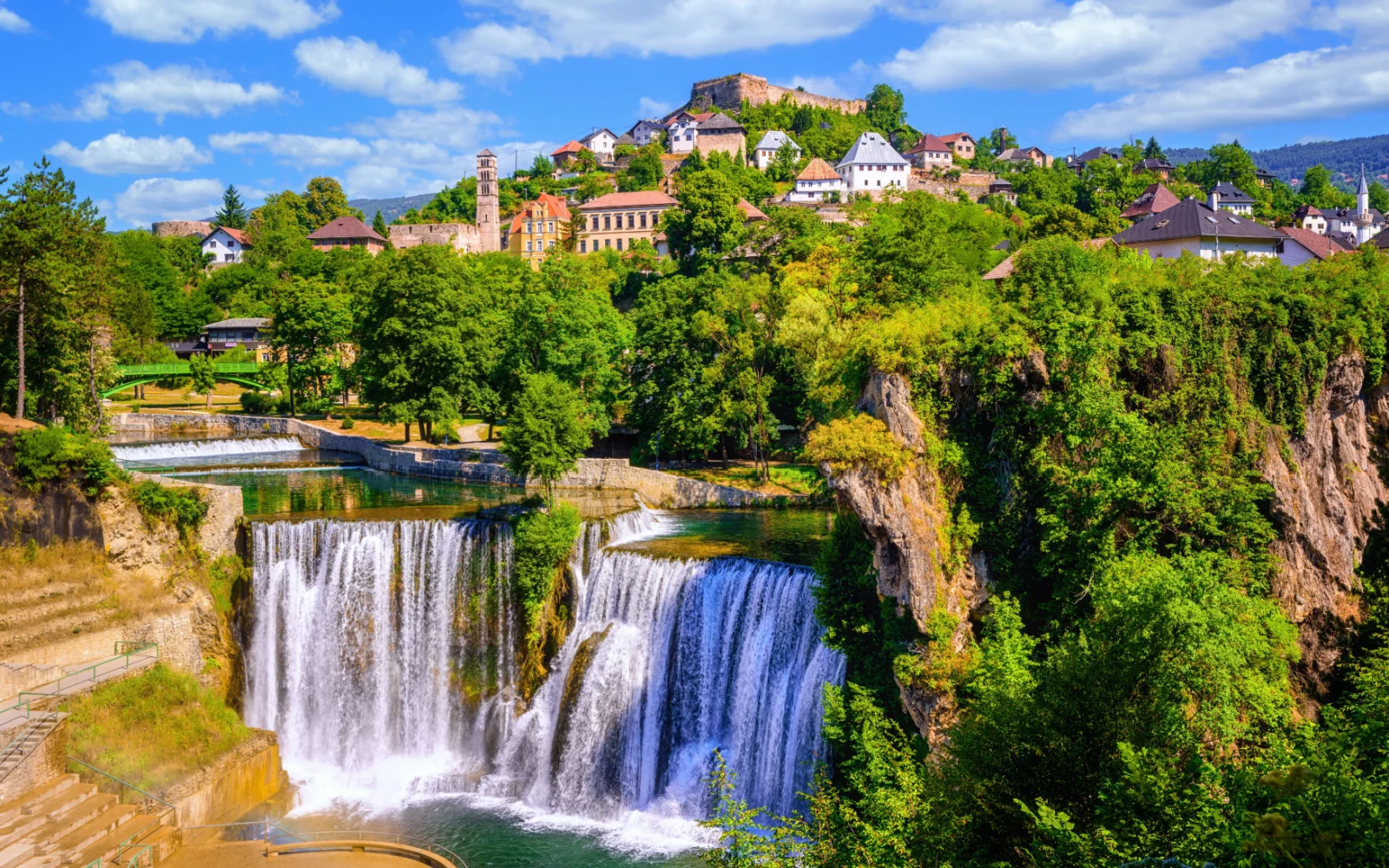Although the world has likely read more negative than positive news in recent years about Bosnia and Herzegovina, the country has been putting in an impressive amount of effort to emphasize its interesting history, amazing scenery, and welcoming environment.
Bosnia and Herzegovina features some of the most diverse terrain in the region, from beautiful beaches along the Adriatic Sea coastline to beautiful forests.
There are plenty of impressive rivers and hillsides to explore as well, including more waterfalls than Germany and France together. But with so many cool areas to visit, how do you find the right one for you?
Don’t worry — we’ll show you where to stay in Bosnia, what to do and which hotels to book in each area, and more. Let us be your guide!
The Best Places to Stay in Bosnia

While some travelers may want to start by spending all their time soaking up the sights in Sarajevo, others may want to get more of a better sense of the region by visiting other communities as well.
Our recommendations for the best places to stay in Bosnia include:
- Sarajevo. The capital and largest city offers a great blend of old and new. Nestled by the mountains and rivers, there’s a lot to appreciate.
- Mostar. Located on the Neretva River, the area retains significant Ottoman influences, with mosques, marketplaces and more.
- Banja Luka. This area is the second-largest city, and the largest in the Srpska Republic. The now heavily-forested area was the site of significant battles between the Turks and Austrians centuries ago.
- Tuzla. The relatively smaller city capitalizes on its history as one of the world’s salt producers.
Where to Stay in Bosnia: Best Areas & Hotels
Travelers in the region can find all sorts of lodging options. Some locations in urban areas emphasize the historic parts of town and access to major attractions.
Others focus on providing views of the countryside and natural wonders. Accommodations run the gamut from chain hotels to independent inns and bed and breakfasts. People are considered friendly and hospitable, especially in tourism-focused areas.
Even though there are strong ethnic and religious divides going back centuries, especially between Muslims and Christians, both faiths place a strong emphasis on politeness and even friendliness to all travelers.
I found this to be especially refreshing on my last trip through the region. As a people who have seen heavy fighting, Soviet oversight, and the redrawing of geographic borders around ethnic lines, all in the last 50 years, it wouldn’t be hard to get cynical.
But the people we encountered were quite friendly and cordial, even hopeful, about what’s ahead for Bosnia and Herzegovina – and they loved showing off their cities.
1. Sarajevo
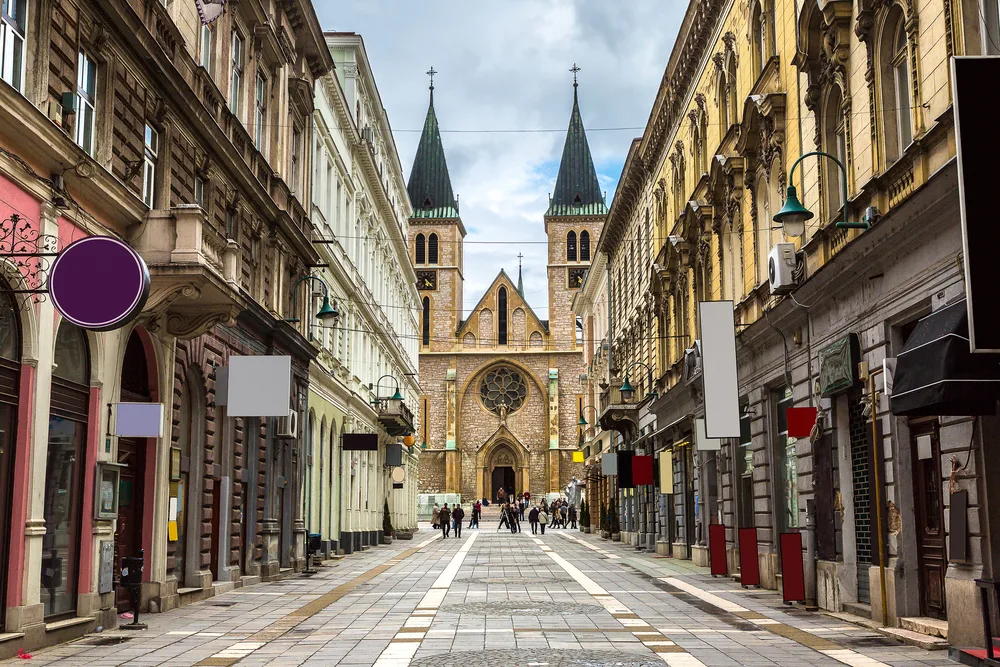
Sergii Figurnyi/Shutterstock
First up on our list is the very best place to stay in Bosnia: Sarajevo. Among its other claims to fame, this city was the first Communist-bloc country to host the Winter Olympics, which it did so in 1984 when it was part of Yugoslavia.
Today, the city offers so many things to appeal to so many interests. Visitors can literally walk to a historic Catholic cathedral, Orthodox church, Jewish synagogue and Muslim mosque in a few blocks.
Same goes for activities: get a cup of coffee, visit a hookah lounge, or enjoy a glass of locally-brewed beer.
Because the city has been occupied by so many domestic and foreign governments over the years, there’s a wide range of art and history that can be seen in all sorts of galleries and museums, plus diverse marketplaces that haven’t changed for decades.
Where to Stay
Budget
- Hostel Center. Visitors can choose between twin rooms, double rooms, or four-bed dormitories with shared bathrooms and showers. The location is near the cable car stop and the War Tunnel. There’s also an inner courtyard, and some rooms have views of the city.
- One Love. Hostel guests can access double rooms, twin rooms, and six-person dormitories. Guests can also visit an on-site garden, barbecue area, and terrace. It’s near City Hall and the Husrev-beg Mosque. Transportation is available from the airport.
Mid-Range
- Pansion River. Rooms in this guest house overlook either downtown or the scenic Pansion River. It is close to the Latin Bridge and Sebilj Fountain, two locations worth visiting. There’s also a sun terrace for guests as well as a restaurant and bar.
- Divan Hotel. Hotel guests can receive a free daily tour of the city, as well as access to a breakfast buffet. It’s surrounded by other restaurants, cafes, and nightclubs in the middle of the Old Town area. Rooms include balconies and private bathrooms.
Luxury
- Hotel Story. This location is near major Old Town attractions like the Bridge of Gabrilo Princip and the City Museum. Private rooms are available, with free toiletries and satellite TV. Guests can head to the breakfast room to enjoy a continental breakfast that also comes in vegetarian, halal, or gluten-free options.
- Hotel Astra. Guests can take advantage of a two-floor cafeteria that includes a large selection of food and drinks. There is also a minibar and satellite TV in the rooms. The hotel is downtown and provides an excellent view of the narrow streets and Ottoman architecture.
2. Mostar
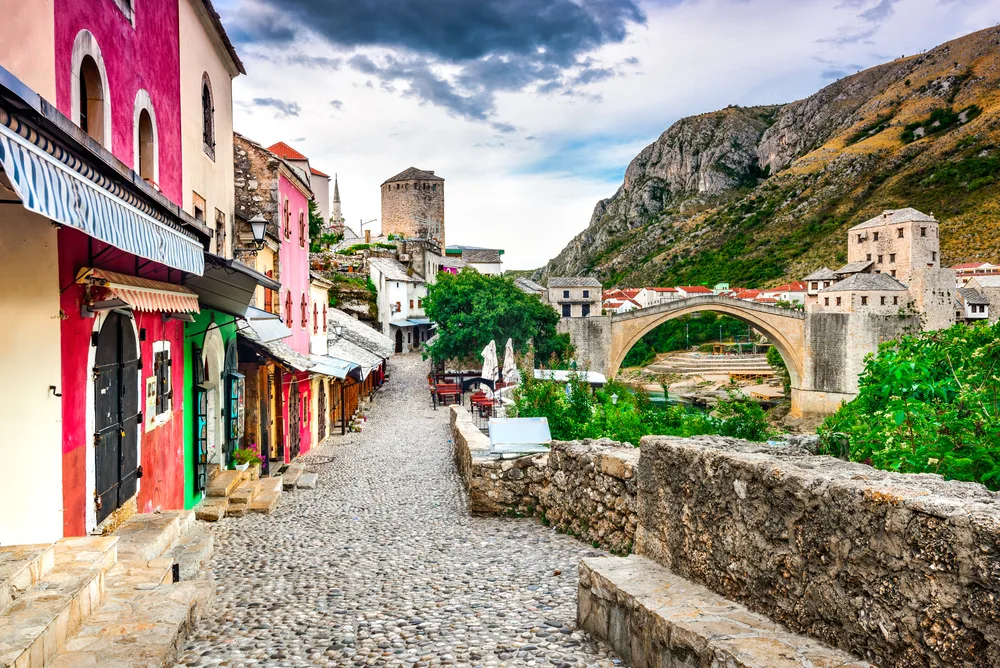
ecstk22/Shutterstock
Mostar is only about two hours southwest of Sarajevo by train but includes all sorts of contrasts. While Sarajevo has all sorts of large, historic buildings of all types and sizes, Mostar is more harmonious, with mostly Croat and Ottoman influences over the years.
The city’s name loosely translates to “Bridge Keeper,” which perfectly describes its role as a guardian of the city’s massive main bridge.
The Stari Most, or the Old Bridge, connects both halves of the city. At a time when the area was considered a frontier post for the Ottoman Empire in the 1500s, officials ordered the creation of a large structure to bring together both sides of the Neretva River.
The bridge stood firm until 1993 when it was badly damaged by the Croatian army. However, there was enough public interest and financial support to rebuild it.
Today, not only it is a focal point of the city but an official UNESCO Heritage Site. Visitors on either side of the riverbank can learn about the city’s rich background along with a variety of attractions like museums and galleries.
Where to Stay
Budget
- Hostel Sema. The hostel offers twin rooms with shared bathrooms near the Old Bridge. Guests can visit a central seating area. Balcony views are available, plus access to a private kitchenette and outdoor barbecue area.
- Pansion Villa Anja. A variety of accommodations are available, including double beds, single and double studios, and larger family rooms. The location offers a free shuttle to the bus or train station. An on-site bar/restaurant provides breakfast and there’s also a supermarket nearby.
Mid-Range
- Villa Botticelli. Rather than being downtown, this location is on the outskirts of Mostar near the village of Blagaj and close to the Medjugorje shrine. There are several restaurants, bars, and grocery stores within walking distance. All guest rooms have balconies or terraces and garden access.
- City Apartment One. An outdoor swimming pool could be appealing especially on hot summer days. The location in a quiet part of town provides family rooms, studios, and double rooms, so can be perfect for any size group. A restaurant and store is also nearby.
Luxury
- HA Hotel Mostar. The 4-star hotel provides spacious rooms, a garden, and a continental breakfast. A bar and restaurant is on site, and the staff can also arrange bicycle rentals and airport transportation upon request.
- Villa Enjoy XL. Why be part of a crowded hostel downtown when you can enjoy the good life on your vacation at this sustainable villa? Guests can enjoy an outdoor swimming pool, barbecue facilities, and a lovely garden. There’s an outdoor fireplace, three bedrooms and one bathroom. The staff is happy to arrange trips, including a suitable daylong picnic area.
3. Banja Luka
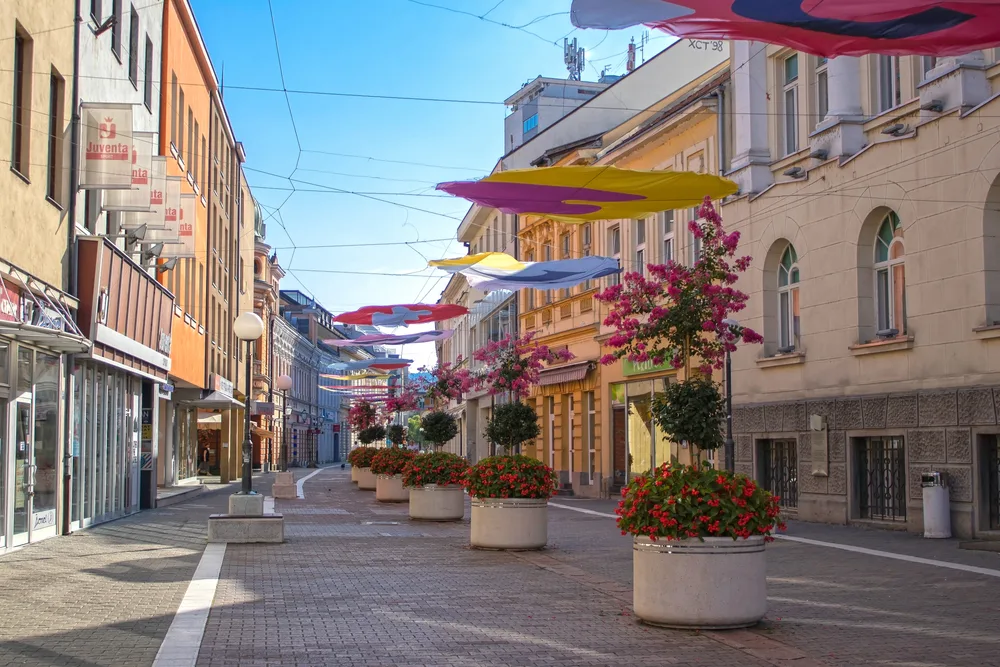
Banja Luka, Bosnia and Herzegovina – August 16 2020 – Gospodska Street in center of city, most popular walking route/Emma7/Shutterstock
The country’s second largest city greatly contrasts with the more urban and dense nature of Sarajevo. Here, there are plenty of parks, lots of forestland, and general emphasis on nature and sustainability.
It’s the northern area of the country at the confluence of two rivers, the Vrbs and Vrbanja. Politically, it’s distinct as well, being the capital of Sprska, the autonomous Bosnian Serb Republic.
Like the other older cities in Bosnia and Herzegovina, the city has influences from the Ottomans, Austrians, Slavic, and Illryians, which is seen in many of the buildings.
Even the most basic structure may be decorated in ornate styles. It’s a very open city, with wide boulevards and generally shorter buildings.
Unlike Sarajevo, which has almost equal number of major faiths, Banja Luka has a majority Muslim population. It is also in the process of rebuilding many mosques that were destroyed.
Where to Stay
Budget
- Sobe Rodic Centar. A variety of rooms are offered at this location that is near the Kastell Fortress. Each room includes a private bathroom and shower, plus a flat-screen TV.
- Smjestaj Vidovic, Slapovi Krupe. Guests at this vacation home can utilize two bedrooms as well as a kitchen, living room with sofa bed, and a bathroom. There’s also a terrace and a garden for those who want to enjoy the scenery.
Mid-Range
- Happy Hill Rooms. This condo hotel provides private rooms and private bathrooms plus a central lounge/seating area. It’s pet-friendly, and includes a garden and picnic area to relax in. Tours of the area are available.
- Hotel Vila Viktorija. It’s in the village of Trn, about 6 miles from the center of Banja Luka. Guests can receive breakfast and also have access to a bar and restaurant with an international menu. All guest rooms include a minibar and some include a kitchenette. An airport shuttle is available.
Luxury
- Hotel Integra Banja Luka. Guests will enjoy four-star service, including a continental or American breakfast, as well as a bar. Rooms have terrace views, and are equipped with refrigerator,minibar, and a teapot.
- Hotel IN. The on-site restaurant includes an extensive menu with American, Dutch, and Argentinian specialties. It also provides a continental breakfast. Guest rooms offer a desk, teapot, minibar and a private bathroom.
4. Tuzla
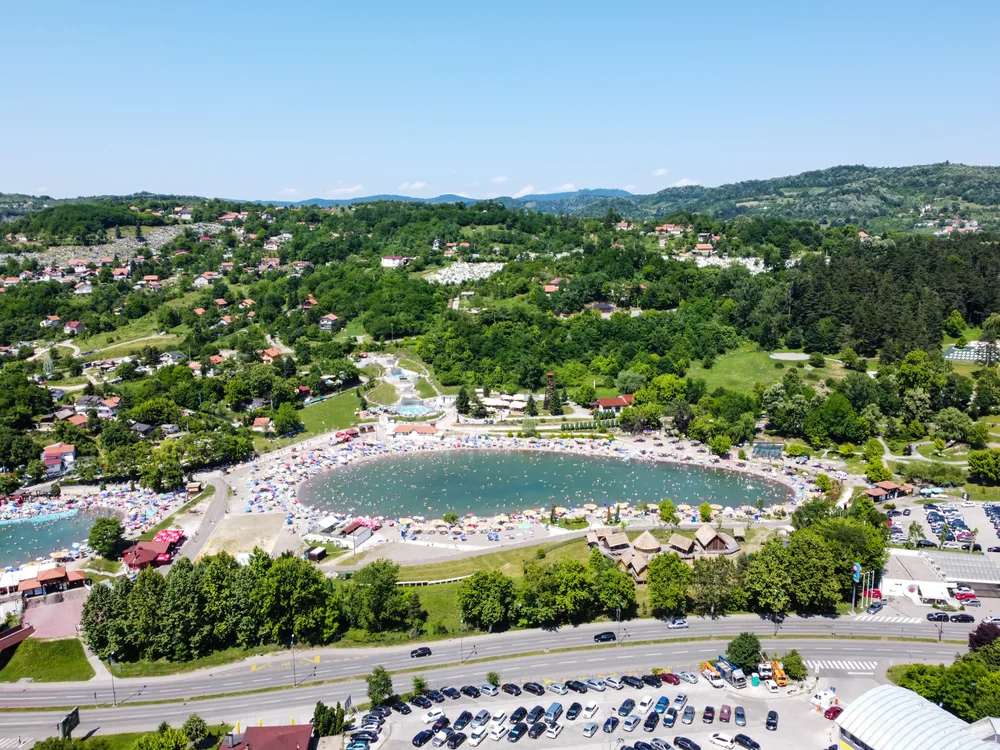
Ajdin Kamber/Shutterstock
Tuzla may be one of the oldest cities in Europe, perhaps going back at least 6,000 years. ‘Tuz’ is the Turkish word for salt, and the city’s name literally means “place of salt.”
The area has been a major salt producer for the world for centuries and today the natural mineral deposits are still being extracted – just with more modern methods.
The salt mines also helped firm the city’s reputation as an especially diverse community where all ethnic groups and religions are welcomed, mostly because they attracted workers from all of the world so there was more exposure to different ideas and cultures.
The lakes have also become a vacation destination: a series of salt lakes are believed to be therapeutic when bathed in or the vapor inhaled from the salt water waterfalls.
There is one downside to the constant mining, however: it has made the town seismically unstable.
There are parts of the area that are noticeably sinking, especially in the Old Town. Every now and then, a new sinkhole is discovered. Visitors can enjoy galleries, museums, and several buildings from different historical eras.
Where to Stay
Budget
- Apartments Dedic. This guest house near the airport includes a shared kitchen, a common terrace with barbecue facilities, tea and coffee service, and a flat-screen TV. A free shuttle from the airport is provided. It’s especially recommended for solo travelers, but family rooms are available.
- Apartmani Hadzic. Guests wanting to visit the Pannonica Lakes area will find this sustainable apartment fairly close by. Shuttle service is available. Rooms include balcony views of the nearby mountains and gardens. There is also a snack bar, bike rental and car rental.
Mid-Range
- University Hotel Dorrah. If you’re interested in shopping, this place is across the street from Bingo City, Tuzla’s main retail area. Guests can access breakfast, tea and coffee service, a bar, and an airport shuttle.
- Pansion Center. Located near to the town’s main square, Solni Trg, the hotel features a breakfast buffet, flat-screen TVs, tea and coffee, and a lounge. Other shops and restaurants are within walking distance, plus a recreation area with swimming, football and tennis.
Luxury
- So&Sol Boutique Hotel. This bed and breakfast is close to the Pannonica Lakes area. Guests can enjoy a buffet or continental breakfast each morning. Rooms include access to a terrace, and close distance to several pubs and cafes.
- Hotel Vertigos. Transportation to and from the airport is available. Each room includes a seating area, tea service, and the choice of an American breakfast, Full English/Irish, or continental breakfast. Some rooms offer patios.
So, Where Should You Stay in Bosnia?
Although the friendly nature of residents, fine food, and beautiful natural scenery is constant through the country, each community in Bosnia and Herzegovina is unique and distinct in terms of the amenities and attractions.
To recap, the best places to stay in Bosnia include:
| 🍺 Best Area for Nightlife | Sarajevo |
| 🎁 Best Area for Shopping | Mostar |
| 🥾 Best Area for Hiking | Banja Luka |
| 🖼️ Best Museums | Tuzla |
So with so much to see and do, and technically no bad area in which to stay, what are you waiting for — book your trip today and experience for yourself all that Bosnia has to offer!



